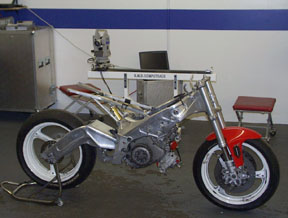|
The heart of the G.M.D. Computrack system is the measurement process. Using a surveying instrument called a theodelite, and a lap top computer, coupled to a track and rail stand, we can measure a chassis to very exacting tolerences. The degree of accuracy produces empirical data used to detect twists and lateral misalignments in the chassis as a whole and in the individual components such as the frame, swing arm, and front end assembly. G.M.D. Computrack focuses on three areas critical for scientific measureing, Accuracy, Repeatability, and Resolution. It it not too difficult to achieve two of the three, however it took over fifteen years of development and nine prototype machines to achieve all three. Many pundits have said this degree of accuracy is far greater than what should be required, however several other companies have tried to copy Computrack, including leading 3-D CMM manufactures, with out any success. In fact others have strived to achieve a level of accuracy that Computrack rejects. It is this level of accuracy, repeatability and resolution that allows each and every G.M.D. Computrack shop to provide the same expertise and quality of service through out the world.
Chassis preparation is minimal. A complete chassis only needs to have the fairing and fenders removed, and many models require no prep work at all. Targets are placed in strategic locations on the chassis, and are used to define the planes and axis of the chassis. Due to the method of target placement and measurement process, we can measure a bike with bent wheels, fork tubes and triple clamps, and still get the accurate assement of the frame and swing arm. Alternative suspension design does not affect the measurement in fact Computrack has been used to measure such bikes as the Britten V1000, BMW Paralever/Telelever, Harley-Davidson Springers, Leading link front ends, and others.
 Unlike in the Automotive industry, there are no " Specs" for motorcycle chassis. Any dealer or repair facility that says they "checked the Specs" is not being completely honest. The only specs are the wheel alignment marks on the swing arm and these give no indication of frame or swing arm twist, or lateral misalignments. Many shops also say "we checked the frame and it's ok." The tolerance that we have found to be acceptable is so small it can not be detected with string lines, straight edges, tape measures or angle finders. These seemingly small numbers are easily felt, but are impossible to see. In fact a 0.2 degree twist extrapolated out 500mm is less than 2mm or 0.080 inches. This means that a chassis that has been misaligned will not show clues on the exterior such as cracked paint or stress marks. In fact with the amount of flex additives in today's paint, cracks in the paint may mean that the frame or swing arm is beyond repair. Many times a damaged frame is not found until the new forks, triple clamps and body work fitted. At this point the technician finds that the front wheel is too close to the chin cowl. This leads to a supplemental with the insurance company and often means the chassis should have been declared a total loss and sent to auction due to high repair costs. Since even a small tip over puts a violent shock force into the frame through the handle bars, every crash repair estimate should include a G.M.D. Computrack measurement. Unlike in the Automotive industry, there are no " Specs" for motorcycle chassis. Any dealer or repair facility that says they "checked the Specs" is not being completely honest. The only specs are the wheel alignment marks on the swing arm and these give no indication of frame or swing arm twist, or lateral misalignments. Many shops also say "we checked the frame and it's ok." The tolerance that we have found to be acceptable is so small it can not be detected with string lines, straight edges, tape measures or angle finders. These seemingly small numbers are easily felt, but are impossible to see. In fact a 0.2 degree twist extrapolated out 500mm is less than 2mm or 0.080 inches. This means that a chassis that has been misaligned will not show clues on the exterior such as cracked paint or stress marks. In fact with the amount of flex additives in today's paint, cracks in the paint may mean that the frame or swing arm is beyond repair. Many times a damaged frame is not found until the new forks, triple clamps and body work fitted. At this point the technician finds that the front wheel is too close to the chin cowl. This leads to a supplemental with the insurance company and often means the chassis should have been declared a total loss and sent to auction due to high repair costs. Since even a small tip over puts a violent shock force into the frame through the handle bars, every crash repair estimate should include a G.M.D. Computrack measurement.
|